TO ALL
My family thinks that this travelogue should be entitled “How to ford a fjord in a Ford.” But our van is a Honda, not a Ford and fjords are clearly not fordable, so that doesn’t seem to fit. At some point, Alan took such nonsense to the extreme by posing the question – “Can President Ford afford to ford a fjord in a Ford?” Whereupon Mike added to the insanity by finding an opportunity to state that he wasn’t sure whether we needed to go back or fjord. One would think that certain people were bored on this trip – maybe they were. We did spend a lot of time in the car. Norway itself was far from boring, but it is a long way from here to there.
Again, we chose the car option rather than flying, because it is cheaper for 6 people, it allowed us to bring food with us and some things in Norway are simply not accessible by plane or train. Plus my dad specifically wanted to go over the bridge from Denmark to Sweden (Did you realize there was such a thing?) and I wanted to see what was between Heidelberg and Oslo – all 1500 kilometers of it. (By the way, supposedly the distance from Rome to Oslo is the same as the distance from Oslo to the northern boundary of Norway. Having now driven the first, I think I’ll pass on the second. Norway is a big country.)


We actually pulled off this expedition for slightly less than $500 / person for 9 days. Most of you know that my Dad is the ultimate miser when it comes to money. Even at 80 years of age, he is content with pretty basic accommodations – most anything is fine as long as he doesn’t have to walk too far at night to get to the bathroom and preferably not to another building. And we have to work to keep him from heading straight for McDonalds for his one meal out per day.
The manifest for this expedition was similar to the Rome trip– my dad and brother (Curt), Alan, Amy, Mike and I – no Marion unfortunately. We just didn’t have room for an extra person since Mike was with us in the car for this entire trip. We really enjoyed having Marion with us on the Rome trip and look forward to more opportunities to travel with her in the future. She was our expense accountant on the Rome trip. I had to take over her job on the Norway trip and it was a real pain. With most expenses being shared between several families, we decided not to try to divide up every bill accurately on the spot but rather to pay for common expenses randomly, keep good records and sort everything out at the end. It worked great. Or at least I came out well at the end!! Ooops, I didn’t say that!
Speaking of such practicalities, Scandinavia (Denmark, Sweden and Norway) has a really neat option for economy lodging. In many of the campgrounds, they have little huts called hytte (pronounced WHOO-teh possibly – Anne can you clarify this?) Some are nicer than others (we learned to ask for ones with a toilet and shower). The beds are often bunk beds, you either have to bring your own linens or pay extra to rent them, and they aren’t terribly spacious. But they are cheap ($100 - $150 per night for six people), they have heat (although we didn’t need / use it), and they usually have a small kitchen with a refrigerator, stove, dishes, etc. Six of our nine nights in Scandinavia, we stayed in huts – the other three in hostels or pensions. We kind of knew about this hut option ahead of time so we had a few sleeping bags with us, but in retrospect we should have had 6 single sheets and 6 duvet covers, and 6 pillow cases with us instead of the sleeping bags.
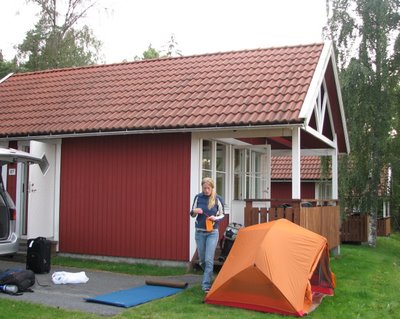
Our basic route was --
*north through Germany to Denmark,
*then east to Copenhagen (spelled Kobenhavn by the Danes),
*across a 10 mile long bridge to Malmo, Sweden,
*then north along the coast of Sweden to Norway,
*on north through Oslo to Lillehammer (where we spent a few hours with a cousin of mine),
*on north to Lom,
*then west over some high passes and along some fjords to Bergen,
*then south through the Setesdal Valley to Kristiansand, Norway,
*then across the Skaggerak Sea by ferry to Denmark
*and home again through Germany (with a slight detour back to Copenhagen to put Alan on a plane).
This last little detour is a good illustration of the absurdity of today’s airline industry policies. When Alan bought his plane ticket to Zurich (to work out of the Google office there for a month), I didn’t yet have our travel plans for Norway finalized. At some point I realized that we could get an extra day in Norway if we put Alan on a plane in Copenhagen on our way back to Germany. As luck would have it, the ticket Alan already had routed him through Copenhagen on the way home to Seattle, but do you think the airline would let him abort the first leg of his trip and just get on in Copenhagen? Absolutely not. The answer was “If you don’t get on in Zurich the rest of your ticket will be canceled.” They also wouldn’t allow him to alter his ticket in any way – not even if he was willing to pay a penalty. The only alternative they could offer was to sell him a whole new ticket. So . . . . . he ended up buying a one way ticket from Copenhagen to Zurich. To get home he flew from Copenhagen to Zurich, spent the night in Zurich and then flew back to Copenhagen and on to Seattle!!!

Denmark and Sweden are members of the EU, but have not adopted the Euro as their currency. Each has their own kind of “kroner” and the conversion rate for each is different. Norway is not a member of the EU. They have had a couple of referendums proposing that they join the EU but both failed – the last one in ’96 by only about 2%. Apparently Norwegians feel (and probably rightly so) that joining the EU can only limit their freedom (in regard to such things as how farm products are marketed) and lower their standard of living. Norwegian currency is yet another “kroner” with yet another conversion rate. It was rather a challenge to come up with the right kind of currency in the right denomination at the right time and to know, even in general terms, what we were paying for any particular item. The conversion rates range from 5.5 to 1 to as high as 7 to l. Seeing prices like “98” on a dinner menu was a little disconcerting. Convincing oneself that “98” of any currency was a good deal was even harder.
The last day of our trip, Amy took on the challenge of trying to compare gas prices for Germany, Denmark, Sweden, Norway, and the US and I’m not sure her brain has recovered yet. Such calculations involve converting from liters to gallons as well as kroners (or euros) to dollars. I THINK that she concluded that gas prices were highest in Sweden – topping out at about $6.00 per gallon. Germany is more like $5.00 per gallon, but of course we can buy government fuel coupons for whatever the US average is – about $2.50 per gallon right now. Unfortunately the coupons work ONLY in Germany. Once we cross the border we’re on the economy.
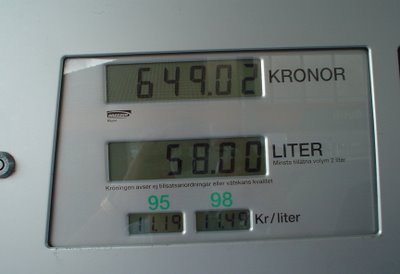
Our visit with my cousin, Anne Risheim, and her husband, Ivar, was one of the highlights of the trip. Neither Anne or I are exactly sure when we last saw each other, but it has to have been at least 30 years. Anne met Ivar (pronounced EE-var) while he was in chiropractic school in Chicago and she was working in a nearby hospital as a pharmacist. He ended up transferring to a school in Iowa but after he graduated, they married and moved to Lillehammer, Norway, not far from the little town in which he grew up. I always thought that Anne’s moving to Norway was kind of an out-of-the-blue thing, but now I know otherwise. Anne’s grandfather was Norwegian. His entire family immigrated to the US together, so Anne doesn’t really have any paternal relatives left in Norway but she does know exactly which farm her grandfather grew up on, etc, etc. So . . . now Anne and Ivar have 2 grown kids – a boy, Hans Eric, who is studying to be a chiropractor at the same school in Iowa from which Ivar graduated and a girl, Elizabeth, who is in pharmacy school in Oslo. Unfortunately we didn’t get to meet either of them. English is spoken fairly commonly in all the Scandinavian countries (even more so than in Germany), but to actually live in Norway you do pretty much have to speak Norwegian, which Anne does fluently. After 25+ years in Norway, she says she even thinks in Norwegian. Anne served us a delicious Norwegian meal – including reindeer meat in the entrée -- and it was lots of fun getting first hand information about what it is like to live in Norway including what is was like to host the Olympics in your hometown. (The Olympics were in Lillehammer in 1996 – remember?)
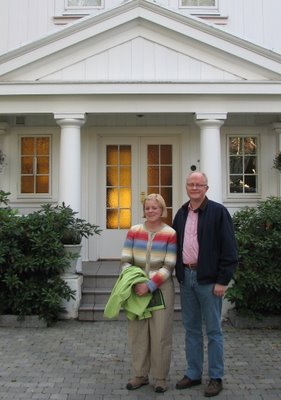
Also Ivar sat down with Mike and laid out a sightseeing plan for us for the next four days. (Take note, Debbie Haynes, we put away our Rick Steve’s book for the better part of four days!!!). This was a crucial thing for Mike in that sometime during that 1500 km journey from Heidelberg to Lillehammer he had begun to question the sanity of this trip – and my sanity in proposing it!!!! Also he had begun looking closely at a map of Norway, especially western Norway, and he had some serious doubts about whether there were actually any roads in the part of Norway I was proposing that we explore – all he could see was water, water, and more water. Ivar was able to assure him that there were roads, that there was a lot to see between Lillehammer and Kristiansand, and that it was doable in 4 days.
Here I must pause for a funny story. In my last travelogue, I alluded to my having a GPS that works in connection with my PDA. As we all know, you get what you pay for and I didn’t pay much for this GPS. There are a TON of annoying things about how it works or doesn’t work. But . . . we did actually used it a fair amount on this trip, although it could seriously be debated whether it solved any more problems than it created. It did get us to Anne’s house and one night it did help us find lodging when things were getting a little tense. But it also lead us astray a time or two and it created some divisiveness among our group in that some of us trusted it and wanted to follow it and others of us (we won’t name names but I wasn’t in this group) were offended by the very idea of letting a computer tell them what to do (ahem . . . . Mike and Amy). On occasion it also provided levity – like when we would get seriously off track and it would say “Make legal U-turn” or when we found ourselves on a road that the GPS didn’t know about and it would responded by saying “Go to nearest road” -- as the cursor on the screen wandered aimlessly through a patch of green.
One other bit of trivia about our time with Anne and Ivar before I move on – We learned that lefsa is in fact an authentic Norwegian food although the way they eat it in South Dakota is NOT authentic. My dad is one quarter Norwegian and he grew up among Norwegians in South Dakota. Lefsa was always a Christmas treat. Lefsa looks a lot like a flour tortilla – in fact it could easily be mistaken for a flour tortillas by the uninitiated – but it is made out of potatoes. In Norway, it is also marketed a lot like a flour tortilla – in bundles of 8 or 10 in a plastic bag displayed on an unrefrigerated shelf. In South Dakota the accepted way to eat lefsa is to spread a thin layer of oleo all over it, sprinkle white sugar on it, fold it into a wedge and eat it as a snack. They don’t eat it that way in Norway. Instead, it is used more like its cousin, the flour tortilla. You put meat in it and roll it up like a burrito. A hotdog wrapped in lefsa is called a lumpa and it is a popular “fast food” option – sold in 7-11’s all over Norway.
When we left Anne’s house, we had 4 days to explore “fjord country” before we had to head home. Since Mike took over the navigating during that time and I was totally engrossed in the scenery, trying to capture it on film . . . . er-r-r memory stick, I’m not sure I could, at this point, actually trace our route on a map. It was all just incredibly beautiful. We took a wrong turn out of Lom and got off Ivar’s route immediately. We were so taken with the scenery it took us a long time to catch on to our “mistake” – if anything in Norway could be called a “mistake” in terms of scenery! We debated about whether to go “back or fjord” and ended up going back. We decided that when a local Norwegian tells you where to go, it’s worth the effort to follow his advice.
In our meanderings from Lom to Kristiansand, we took three different car ferries across various fjords. The views from the ferries were incredible -- the views from the roads no less so. The roads would go right beside the fjords for awhile and then over a high mountain pass to another fjord. Alan has decided that the purpose of switchbacks is to give the passengers on both sides of the car a chance to see the views. My dad has decided that the purpose of tunnels is to give your eyes a rest from the views – so your brain doesn’t go on overload. Most of our four days in “fjord country” were overcast, but not so foggy as to obscure the views. A couple of days the skies cleared about 4:00 in the afternoon. It would have been nice if it had been a little sunnier and probably pictures would have turned out a little better, but it wasn’t a big deal. The scenery was still absolutely incredible.

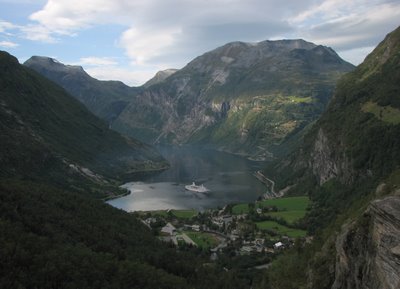
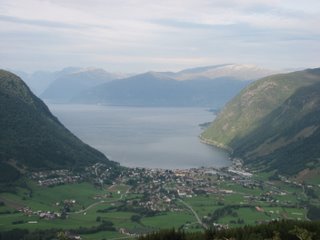
Norway is without a doubt, my favorite European county so far. It is Switzerland with a third as many people. Plus something about Norway feels familiar -- more like America than other European countries. I’m not sure exactly what that is all about. Maybe it’s just that Norway is less crowded than Germany. You can actually be out of sight of any town for long periods of time – long enough to warrant having signs along the road that tell you how many kilometers to the next town. They do have these in Germany, but there aren’t nearly as many as I am used to, especially having grown up in the west where things are fairly spread out. My attitude toward Norway is probably also influence by the fact that my all time favorite classical piano composition is written by a Norwegian - Edvard Grieg – the only really well-known Norwegian composer. His “hit” is called the “Norwegian Piano Concerto in A minor.”
The mountains around the fjords were slightly more rocky and barren and not quite as vertical as I had expected. One of the surprises was the abundance of waterfalls. If we had stopped to take a picture of every waterfall we saw we’d still be in Norway today. The waterfalls typically start “falling” at the very tops of the mountains (almost like the pouroffs in Big Bend National Park in Texas). How does that work? Obviously the “top” isn’t really the top and it is more of a plateau than a peak.
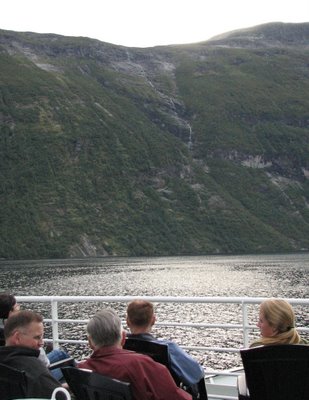
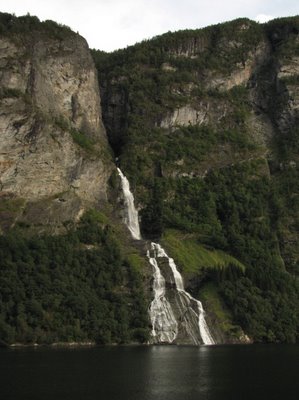
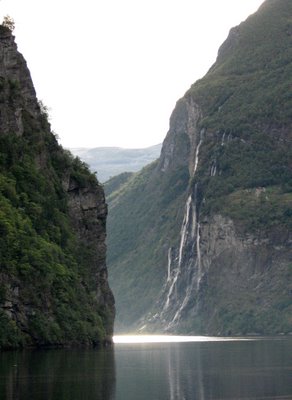
The fjords were every bit as spectacular as I had expected. What I hadn’t expected was the high plateaus in between the fjords. In between every fjord was a tundra area with expansive views, glaciers, invigorating crisp air, tundra vegetation and more lakes. It was every bit as spectacular as Trail Ridge Road in Rocky Mtn Nat’l Park or the Beartooth Parkway in northern Wyoming / southern Montana (Lisa S. and Ana take note!) although the ground cover was a little different. The foliage was just starting to turn and the ground cover was a pleasing blend of greens and yellows and reds and browns. . It was a gorgeous time of year. There was a lot of a particularly brilliant red plant with white fluffy seeds that Amy thinks is called fireweed. It was either beginning to go to seed or entirely gone (depending on the elevation) but it was pretty nevertheless.
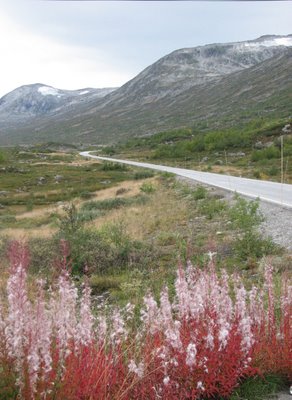
Although there are a lot fewer people in Norway than in Switzerland “fjord country” is NOT a wilderness. There are farms scattered along the edges of the fjords and also above them – like around the lakes in Switzerland, just not as many. My dad spoke for all of us one day when he pointed to a seemingly inaccessible collection of farm buildings way in the distance, across the water, and asked “Whatever do you suppose would possess a guy to put his farm there?”
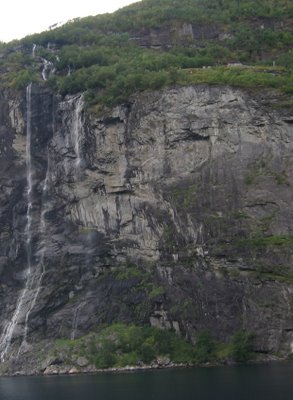


Norwegian barns and farm houses are typically kind of an earthy color of red (barn red . . . duh). The barns typically have two or three grain silos attached to one side and a sturdy permanent ramp for hauling in grain on the other side providing easy access to the second story.

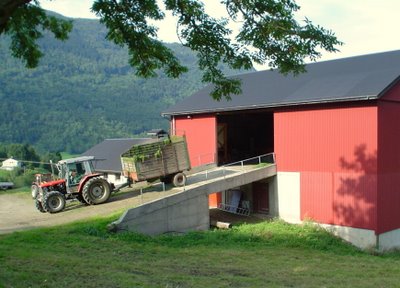
Sod roofs are really common on all kinds of buildings – houses, roadside outhouses, bus stop shelters, etc, etc – and not just on older historic buildings, but brand new ones as well. Ivar assured us that sod roofs do NOT leak, but we didn’t think to ask him “What is the advantage of a sod roof?” It is cheap insulation? Low maintenance? Or just traditional?
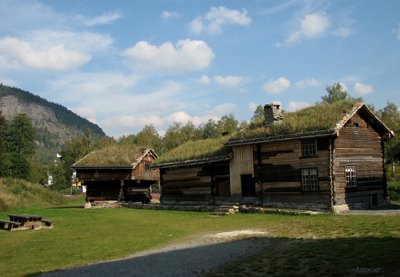
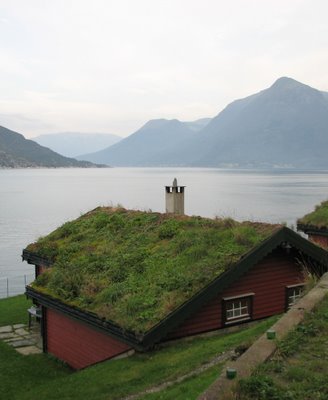
There were also lots of slate roofs.
The pieces of slate were as big as two feet square and laid out in a diamond pattern.
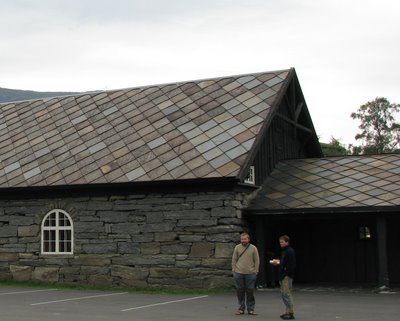
The medieval Norwegian equivalent of a log cabin is a stave church. Stave churches are made out of planks instead of logs and the planks are vertical instead of horizontal, but otherwise the concept is similar. The planks are sealed with a thick coat of tar. Stave churches are typically ornamented with dragons (like the ones on Viking ships) which were supposed fight off evil spirits -- the Norwegian equivalent of a gargoyle? Among the few stave church that are still left is one in Lom which we stopped to see on our first day out from Lillehammer.


The roads in “fjord country” are theoretically two-way, but there is rarely any center stripe and the best way to deal with oncoming traffic is to pray that it doesn’t show up in the wrong place (of which there are many) and then be prepared to back up if it does. The roads are every bit as narrow and windy as the Amalfi Coast, just without the horrendous traffic. If you’ve driven the road to Hana on the island of Maui in Hawaii and didn’t like it, don’t drive in fjord country -- take a cruise! Again Amy volunteered to do most of the driving and no one argued with her. One of my dad’s most-repeated phrases when he is traveling with us in Europe is “I’m glad you folks are doing the driving.” I sat in the front passenger’s seat for most of the four days and took pictures out the windows as Amy drove. Amazingly, I can’t always tell for sure which pictures were taken with the car in motion and which during one of our many stops along the way.
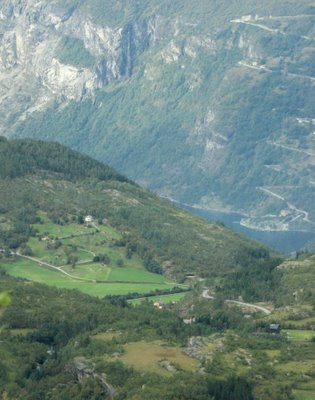
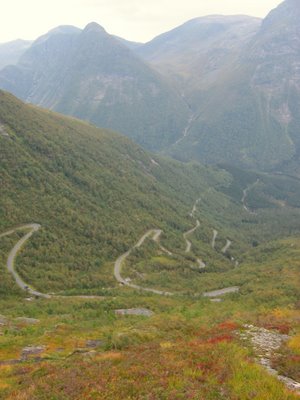
Our basic routine for the four days we were in Norway involved
*hitting the road about 8:00AM
*driving until someone got the urge to stop and take pictures and soak in the scenery,
*eventually moving on but then stopping again when the next urge hit
*making sandwiches at lunchtime from the food we brought along
*looking for lodging when it seemed like the time to do that
*eating supper in a restaurant and then retiring to our cabin
*playing four handed pinochle until 10:00 or 11:00 PM
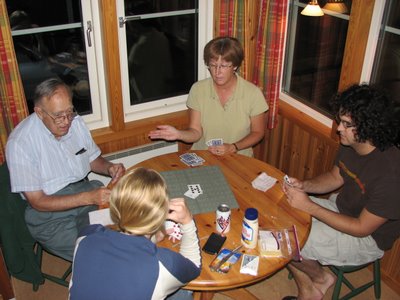
This last activity somehow turned out to be a highlight of the trip.
One night at supper, Alan got us out of the restaurant by commenting that we were “cutting into our pinochle time.”
Mike and Curt bowed out of this activity.
Mike doesn’t particularly like to play cards.
He was quite happy to hit the sack early.
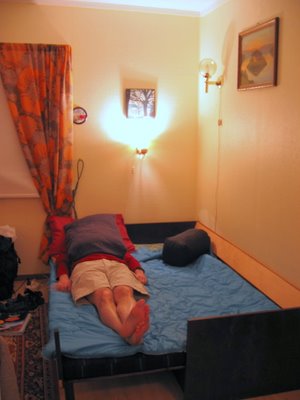
Curt used to be a great card player but for some mysterious reason he has been turning down all opportunities to play for the past several years. Alan and Amy were new converts to the game, but became great strategists quite rapidly.
One day we broke the routine and went into Bergen for a few hours to do laundry and explore the harbor. Bergen was an interesting town. I wouldn’t have minded spending a little more time there. The open-air market at the harbor had basically two things for sale: (1) every imaginable variety of fish, either fresh or dried and (2) sweaters, hats, scarves, and mittens in every imaginable color and style.
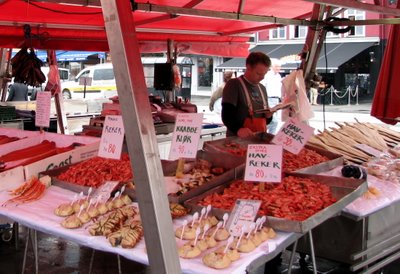
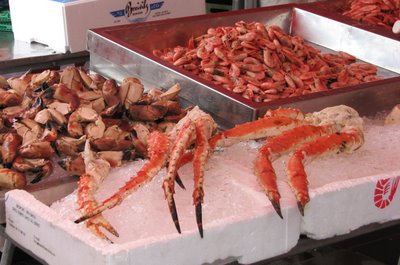
One day we came across a rather large herd of goats along the road. As soon as we stopped the van and rolled down the windows to take pictures they came to visit us and we had a lot of fun observing and taking pictures.
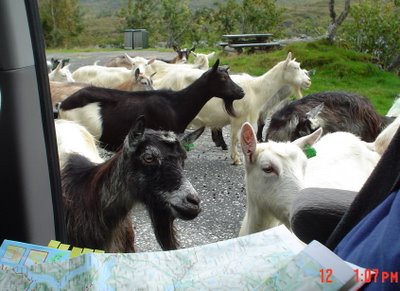

We were in Scandinavia from Sept 8-16 and it was clearly off season. With the exception of our night in Lillehammer, we left Heidelberg without any lodging reservations. When we decided it was time to stop for the night, we just sort of found something. My only regret about this is that I wish we had had a cell phone with reasonable rates so that we could have done the “looking” a little more efficiently (My German cell phone works in other countries, but it is really expensive.) However, the problem was not that some places were full, it was that some places were closed for the season. I’m not sure what makes the tourist season so short in Norway – the weather in September was really nice and the length of the days was not significantly different than in Heidelberg – but I’m not complaining. It was nice to have the roads to ourselves. A few closed campgrounds is a small price to pay for that luxury.
Apparently they do get a lot of snow in Norway in the winter and fog is a big problem, but wind is not. Some cars have an extra of set of “headlights” that are specifically for fog. Also some stretches of highway are lined with streetlights – even stretches that are out away from the towns, in the middle of nowhere. My dad observed right away that these “fog lights” were mounted on really spindly polls – totally incapable of withstanding wind. Ivar was able to clarify that wind really isn’t an issue in Norway – which means also that roads don’t drift closed like they do in South Dakota and Wyoming.
One last little anecdote before I close. After we dropped Alan off at the airport in Copenhagen, we went into the touristy part of the city and found someplace to eat dinner. After dinner we went into a little ice cream shop. (European ice cream is in a whole other class from anything you can buy in the US and we seize every opportunity to partake of it.) In this little “Eis Cafe,” the shopkeeper’s son was taking care of customers while he was busy doing something in the back. This kid was incredible. He wasn’t Danish – Mike thinks Turkish maybe – and he couldn’t have been more than about 8 years old. To dip ice cream he had to stand tiptoe on a bench. Even then he had to use every inch of his reach to get to the containers that were farthest away. His dad came out to check on him at one point while he was waiting on us but there was no need to take over. When the kid was done serving all five of us, he rang up the bill on a cash register that was just below his eye level, took our money, returned our change and thanked us politely. Boy was I impressed! Does this sort of thing happen anywhere in the US anymore??? Or are we too busy sending your kids to school and teaching them to play the piano and do sports to give them the opportunity to be responsible and practice real life skills.

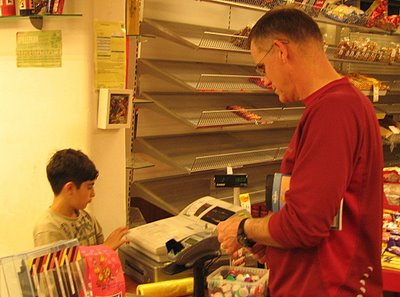
So that is our trip to Norway. I would like to go back again in the winter – to ski and to see the northern lights. Mike would like to go back and check out the Aurlandsdalen Valley -- Norway’s Grand Canyon according to one of our tour books. As we approach the end of our 3 years in Europe somehow it seems like our list of travel goals is getting longer not shorter. Now that we’ve seen the road between here and Norway, we will probably fly if we go again. Ryanair has some good rates to Oslo.
Stand by for my next travelogue on Budapest, followed by Belgium and then Northern Ireland. And feel free to post comments on this or any other travelogue. I changed the settings so that you no longer have to be a “registered user” to do that. Of course e-mails are always welcome, too.
Nancy
For more pictures of this trip go to
http://picasaweb.google.com/nancy.strohm?pli=1



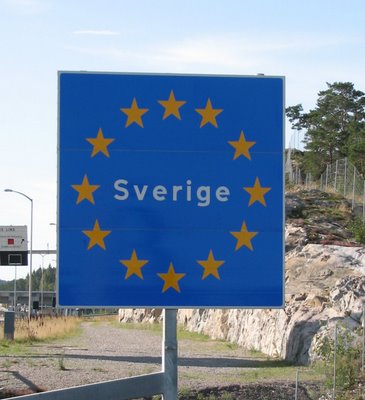
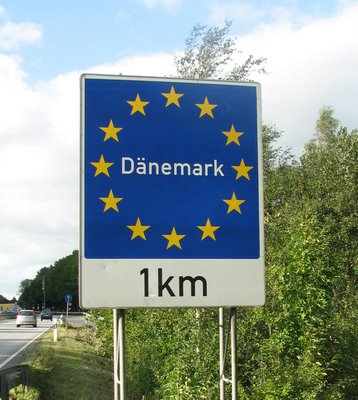



















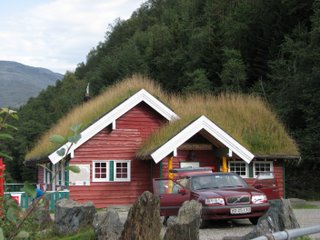













No comments:
Post a Comment